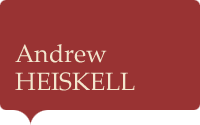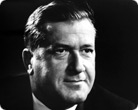Andrew Heiskell's publishing career spanned four decades: he rose from editing science pictorials for Life magazine to running Time, Inc. He was also well known as an effectual philanthropist who helped rebuild the New York Public Library and build low-cost urban housing around the country.
The son of American expatriates, Heiskell was born in 1915 in Naples, Italy. His parents separated several years later and Heiskell and his sister spent their childhood on the continent with their mother, a West Virginia steel heiress. Heiskell grew up speaking several languages, and despite his inconsistent elementary education, excelled in his Parisian secondary education. In 1935, 20-year-old Heiskell arrived in the United States to attend Harvard Business School, but left after a year, saying he "hated business," to move to New York City.
After a brief stint at the New York Herald-Tribune, Heiskell began at Life in 1937. As he moved up the ladder, he introduced high-profile guest writers such as Winston Churchill and President Harry Truman and in 1946 he was named the magazine's publisher. Heiskell became chairman of Time, Inc., in 1960, a post he held for twenty years, establishing profitable projects such as Time-Life Books and Money magazine. One of his greatest successes was his 1974 founding of People magazine, whose popularity helped usher in the modern age of celebrity and human-interest media. He became known for upbeat, urbane, and efficient leadership.
After race riots rocked many American cities in the late 1960s, Heiskell put his skills and energy into the Urban Coalition, a nationwide network of community-based councils that addressed the problems of urban decline. As part of this project, Heiskell helped advance more than 600 million dollars' worth of new housing in the Bronx. In 1978, he joined the New York Public Library board and led a 12-year effort to rebuild the library and the adjacent Bryant Park. In gratitude, the library opened a branch to serve blind and handicapped patrons and named it for Heiskell. He was also active in the Institute for International Education, the Lincoln Center Theatre, Common Cause, and People for the American Way. Despite his lack of formal education, he was elected an overseer of Harvard University.
Andrew Heiskell was often described as a giant of a man, for his power, self-assurance, and six-foot-five height. He married three times: first, to Cornelia Scott, with whom he had two children, Diane and Peter; then to actress Madeleine Carroll, with whom he had a daughter, Anne Madeleine (who died at age 33); and, finally, to Marian Sulzberger Dryfoos in 1965. Dryfoos's family published the New York Times and she shared her husband's dedication to philanthropic ventures; their marriage lasted until Heiskell's death in July 2003.
In 1987, he recorded an extensive autobiographical interview with the Columbia University Oral History Research Office (his wife Marian had recorded a shorter interview in 1967). Ten years after his Columbia interview, he published his memoirs, entitled Outsider, Insider: An Unlikely Success Story.















